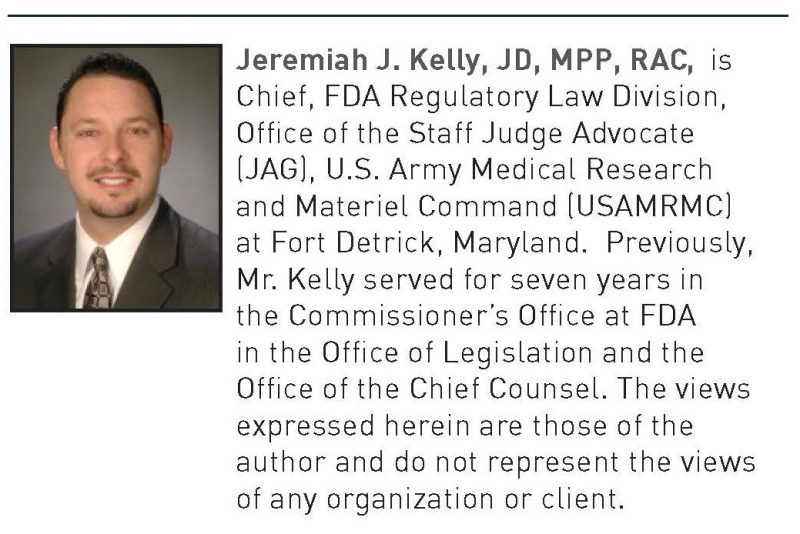
Public Law 115-92: A New Era of Collaboration between DoD and FDA
by Jeremiah J. Kelly
On July 10, 2018, the U.S. Food and Drug Administration (FDA) granted the Department of Defense (DoD) an emergency use authorization (EUA) under §564 of the Food, Drug and Cosmetic Act (FDCA) to enable the emergency use of Pathogen-Reduced Leukocyte-Depleted Freeze-Dried Plasma manufactured by the French military (referred to in the EUA as French FDP).1 FDA’s action is significant for the medical care of the nation’s warfighters, but it may not have been possible at this time last year.
The legal framework governing collaboration between DoD and FDA was altered significantly on December 12, 2017, when the President signed Public Law (PL) 115-92, thereby expanding the EUA authority and creating a new era of collaboration between DoD and FDA related to the development of medical products to treat the unique needs of military personnel.2
Wait, the Department of Defense Is Engaged in FDA-Regulated Medical Product Development?
Indeed, it is. DoD sends its brave men and women in uniform across the globe to fight the nation’s wars in the most austere environments and environmental conditions, often encountering significant battlefield injury and trauma, rare infectious diseases endemic to a foreign region of the world, and experiencing clinical and rehabilitative needs due to brain, extremity, or tissue damage. Accordingly, DoD is tasked with the research and development (R&D) of drugs, biologics, and devices to treat the unique needs of the warfighter to accomplish its diverse national security mission.
DoD, through the U.S. Army Medical Research and Materiel Command (USAMRMC), the Joint Program Executive Office for Chemical, Biological, Radiological and Nuclear Defense (JPEO-CBRND) and other DoD components, has fielded revolutionary medical products that have impacted not only the warfighter, but also global health as those innovations become adopted by the general public.3 If you have heard of medical breakthroughs in infectious disease, trauma care, diagnostics, or countermeasures against chemical, biological, radiological, or nuclear (CBRN) threats, there is a high likelihood that you can trace this innovation back to DoD R&D.
How Did We Get P.L. 115-92?
In the Fall of 2017, French FDP was licensed and available in other countries and used by DoD special operators under an expanded access IND protocol under 21 CFR §312.315. DoD was concerned that French FDP may not be available for use in conventional forces should a conflict with North Korea break out. In light of this concern, Congress added §716, “Additional Emergency Uses of Medical Products to Reduce Deaths and Severity of Injuries Caused by Agents of War,” to H.R. 2810, the Fiscal Year 2018 National Defense Authorization Act (FY 18 NDAA). This provision provided the Secretary of Defense the authority to authorize emergency uses of investigational medical products where it was unrelated to a CBRN threat.4 But this approach, though confined to the military and use outside the United States, would have shifted the ultimate responsibility of EUA decision-making from FDA to DoD.5
FDA and other interested parties objected to this approach,6 leading to a brief legislative struggle between the agencies.7 DoD and FDA held well-reasoned positions on how best to balance the needs to eliminate the gap in the current EUA authority, prioritize DoD medical products, and protect soldiers through the objective and rigorous risk-benefit calculous required of EUA decision-making.
Ultimately, a compromise emerged between the positions of DoD and FDA whereby DoD would get both the expansion of the EUA authority beyond CBRN threats for battlefield trauma care and an expedited approval mechanism for DoD medical priorities, but where FDA retained the exclusive authority to authorize an EUA. This compromise approach was signed into law on December 12, 2017, as P.L. 115-92 and immediately repealed the momentary DoD EUA authority of §716 of the FY 18 NDAA, which became law hours earlier.8
What Are the Features of P.L. 115-92?
There are four major provisions of Public Law 115-92:
- Expansion of the Emergency Use Authority.
Section 1(a) amends the EUA statute at §564 of the FDCA (21 U.S.C. 360bbb-3) by expanding the current scope of a potential Secretary of Defense determination of a military emergency to read as follows:
(B) a determination by the Secretary of Defense that there is a military emergency, or a significant potential for a military emergency, involving a heightened risk to United States military forces, including personnel operating under the authority of title 10 or title 50, United States Code, of attack with – (i) a biological, chemical, radiological, or nuclear agent or agents; or “(ii) an agent or agents that may cause, or are otherwise associated with, an imminently life-threatening and specific risk to United States military forces.9
The new subsection (b) of §564 is now given two subsections. The first retains the pre-existing CBRN basis for a Secretary of Defense determination, but the second adds a completely new basis, namely, the risk of attack by “an agent or agents that that may cause, or are otherwise associated with, an imminently life-threatening and specific risk to United States military forces.” This expansion of the EUA capability for DoD is significant because the pre-existing scope of a potential DoD determination was limited to CBRN threats only. DoD medical product developers were often unable to justify an EUA request for urgently needed investigational medical treatments for battlefield trauma scenarios where there is no clear link to a CBRN threat. This gap in the EUA capability left mass casualty and battlefield trauma care options limited to expanded access IND use.
- DoD Requests for Expedited Development of Military Medical Priorities.
Section (b)(1) of P.L. 115-92 allows DoD to request that FDA “take actions to expedite the development of a medical product…if there is a military emergency, or significant potential for a military emergency, involving a specific and imminently life-threatening risk to United States military forces of attack with an agent or agents, and the medical product that is the subject of such application, submission, or notification would be reasonably likely to diagnose, prevent, treat, or mitigate such life-threatening risk.”10
This section covers all investigational or premarket approval or notice applications of both the FDCA for drugs and devices, and the Public Health Service act for biologics. This section requires DoD to substantiate its request for expedited development by citation of a potential for a military emergency involving a “specific and imminently life threatening risk” to the warfighter and a direct relationship between that threat and the indication for use of the product. While this text does not require that DoD be the sponsor of the regulatory application at issue, the request must come from DoD and, accordingly, there must be a relationship between DoD and (if DoD is not the sponsor) the private entity or other Federal agency sponsoring that medical product.
- FDA’s Response May Offer Optimal Flexibility to Expedite Development for DoD’s Medical Priorities.
In response to a DoD request described above, the statute gives FDA authority to “expedite the development and review of an application or notification with respect to a medical product” which can include holding meetings with the sponsor and the review division, providing the sponsor with guidance on efficient clinical and non-clinical needs for approval or clearance, involving senior FDA leadership, using cross-disciplinary teams for review, providing advice on efficient trial designs, applying any expedited approval program to expedite the development and review of the medical product, and permitting expanded access to the medical product during the investigational phase.11
Section 1(b)(2) gives FDA the authority to bring to bear a wide range of tools to expedite development of DoD medical product priorities. In fact, FDA may use a tool not specifically enumerated in this section if appropriate to expedited development and review of DoD’s stated medical product priority. FDA’s expedited review programs—Fast Track, Breakthrough Therapy or Device, Accelerated Approval, Priority Review—involve consideration of the serious condition the product is intended to treat, the currently available therapy, and the unmet medical need.12 Here, Congress is authorizing FDA to use these expedited approval mechanisms in response to the need articulated by DoD’s request pursuant to §1(b)(1) of the statute even absent absolute compliance with the full terms of the underlying expedited review program contemplated.
- Statutorily Directed Meetings between DoD and FDA.
In addition, there are two sections that direct DoD and FDA to engage in “enhanced collaboration and communication.”13 First, §(b)(3)(A) requires semi-annual meeting between DoD and FDA for “the purposes of conducting a full review of the relevant products in the Department of Defense portfolio.”14 Second, §1(b)(3)(B) requires quarterly DoD and CBER meetings “to discuss the development status of regenerative medicine advanced therapy, blood, and vaccine medical products and projects that are the highest priorities to the Department of Defense (which may include freeze dried plasma products and platelet alternatives).”15 These meetings offer the hope of long-standing communication and collaboration between DoD and FDA. In addition, this statutorily-directed communication and coordination forces both parties to improve their own end of the relationship. These provisions require DoD to communicate with a “single voice” on its most urgent medical product priorities. In addition, FDA is now forced to give appropriate and sustained attention to DoD medical product development priorities.
Is Progress Being Made?
Significant progress is being made as DoD and FDA work to implement P.L. 115-92. The July 10, 2018 FDA grant to DoD of the EUA for French FDP is a significant milestone in the implantation and operation of P.L. 115-92. Both DoD and FDA anticipate full licensure of this product by the end of 2018. 16
The EUA for French FDP was also foreseeable given that DoD and FDA have worked hard to implement P.L. 115-92 since December 2018. In early January 2018, FDA released an “Initial Work Plan for Products Relevant to the Department of Defense (DoD),” which states “[f]or the initial purposes of this work plan for CBER, current top priority DoD programs include freeze-dried plasma, cold-stored platelets,17 and cryopreserved platelets.” The Initial Work Plan was accompanied by a joint statement by DoD Health Affairs and FDA on January 16, 2018.18 The Plan states that FDA will take seven steps to enhance collaboration and coordination with DoD’s priority development programs: (1) better understand the portfolio and developmental priorities of DoD; (2) treat all priority DoD development programs as if they had received breakthrough designation; (3) undertake review of prior advice to DoD and other sponsors of relevant products; (4) provide extensive manufacturing and clinical advice for prioritized products; (5) develop and issue guidance to facilitate the availability of products needed by DoD; (6) maintain an open line of communication to revisit and refine priorities over time; and (7) ensure accountability for FDA commitments to DoD.19
It is clear that DoD and FDA are working hard to implement P.L. 115-92. The two agencies will likely continue to work together to implement this statute via a formal memorandum of understanding (MOU) and it is anticipated that FDA will issue formal guidance on this new program in the future.
Conclusion
P.L. 115-92 has ushered in a new era of collaboration between DoD and FDA. If sustained, this collaboration and communication will yield improved battlefield medical care for our nation’s warfighters. P.L. 115-92 is a “win-win” for both DoD and FDA. This law is also a “win-win” for military medicine and global health.
- U.S. Food and Drug Administration, News Release, FDA Takes Action to Support American Military Personnel by Granting an Authorization for Freeze-Dried Plasma Product to Enable Broader Access while the Agency Works Toward Approval of the Product, (July 10, 2018), available at https://www.fda.gov/NewsEvents/Newsroom/PressAnnouncements/ucm612893.htm (last visited on July 10, 2018) [hereinafter FDA Press Release on French FDP EUA].
- Pub. L. No. 115-92, 131 Stat. 2023-2025 (Dec. 12, 2017).
- While the primary medical product developers within DoD are USAMRMC and JPEO-CBRND, there are other DoD components that also fund earlier stage research regulated by FDA, including the Joint Science and Technology Office of the Defense Threat Reduction Agency and the Defense Advanced Research Projects Agency. If these activities require a DoD regulatory sponsor, they would rely on the U.S. Army Surgeon’s delegation, as the Executive Agency for such activities, to USAMRMC to assume the legal risks associated with FDA sponsorship of any clinical investigation under an investigation new drug application (IND) or investigational device exemption (IDE).
- 716, Pub. L. 115-91, 131 Stat. 1283 at 1438-1439 (Dec. 12, 2017).
- Id. at 1439.
- See Letter to Senator John McCain et al. from 5 Former FDA Commissioners (Nov. 9, 2017), https://cspinet.org/sites/default/files/attachment/former-commissioners-letter.pdf; see also, Laurie McGinley, Clash Over Drugs: Defense Bill would allow combat troops to use unapproved pills, devices, Washington Post (Nov. 10, 2017),https://www.pressreader.com/usa/the-washington-post/20171110/281526521335893.
- See Robert King, FDA and Pentagon in turf war over product approvals,” Washington Examiner (Nov. 7, 2017), https://www.washingtonexaminer.com/fda-and-pentagon-in-turf-war-over-product-approvals; Robert Book, FDA-DoD Turf War Sheds Light on Larger Problem,” Forbes (Nov.29, 2017): https://www.forbes.com/sites/theapothecary/2017/11/29/fda-dod-turf-war-sheds-light-on-larger-problem/#23967a50d4e9; Terry Turner, Defense Bill Could bypass FDA Drug, Device Approvals,” Drug Watch (Nov. 8, 2017, modified April 17, 2018), https://www.drugwatch.com/news/2017/11/08/defense-bill-bypass-fda-drug-device-approvals/; Dan Diamond, How to Reboot the FDA, Politico: The Agenda (Dec. 13, 2017), https://www.politico.com/agenda/story/2017/12/13/fda-approval-alternatives-000593.
- “REPEAL – Effective as of the enactment of the National Defense Authorization Act for Fiscal Year 2018, subsection (d) of section 1107a of title 10, United States Code, as added by section 716 of the National Defense Authorization Act for Fiscal Year 2018, is repealed.” §1(c), Pub. L. 115-92, 131 Stat. 2025 (Dec. 12, 2017).
- Id. at §1(a) (emphasis added).
- Id. at §1(b)(1).
- Id. at §1(b)(2).
- U.S. Food and Drug Administration, Guidance for Industry – Expedited Programs for Serious Conditions – Drugs and Biologics (2014).
- 1(b)(3), Pub. L. 115-92, 131 Stat. 2024 (Dec. 12, 2017).
- Id. at §1(b)(3)(A).
- Id. at §1(b)(3)(B).
- FDA Press Release on French FDP EUA, supra, n.2.
- U.S. Food and Drug Administration, Initial Work Plan for Products Relevant to the Department of Defense at p.1 (Jan. 2018), https://www.fda.gov/downloads/EmergencyPreparedness/Counterterrorism/MedicalCountermeasures/MCMIssues/UCM592562.pdf.
- U.S. Food and Drug Administration, FDA and DoD launch program to expedite availability of medical products for the emergency care of American military personnel, (Jan. 16, 2018), https://www.fda.gov/NewsEvents/Newsroom/PressAnnouncements/ucm592581.htm.
- Id.
Programs
Update Magazine
August/September 2018











